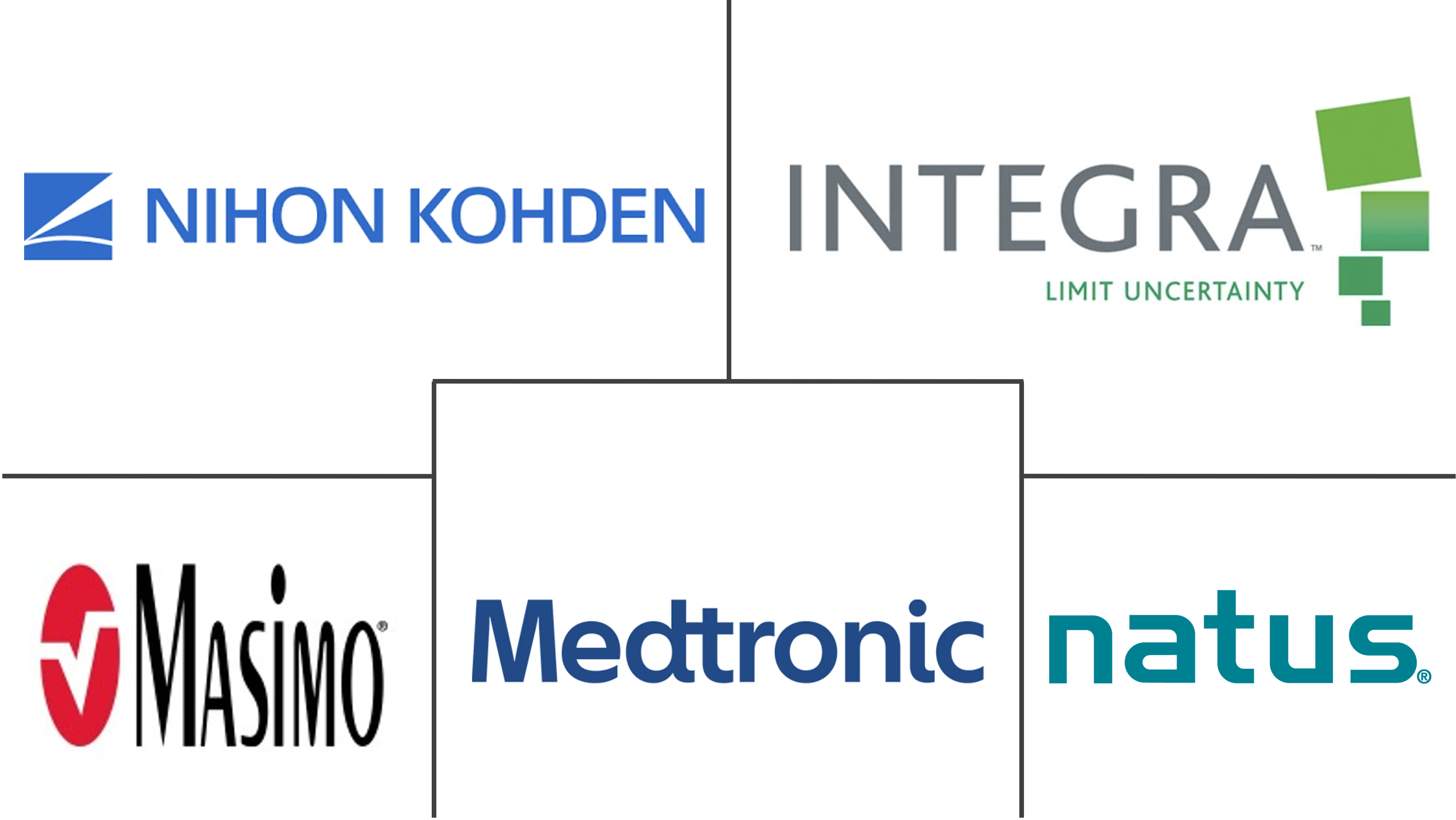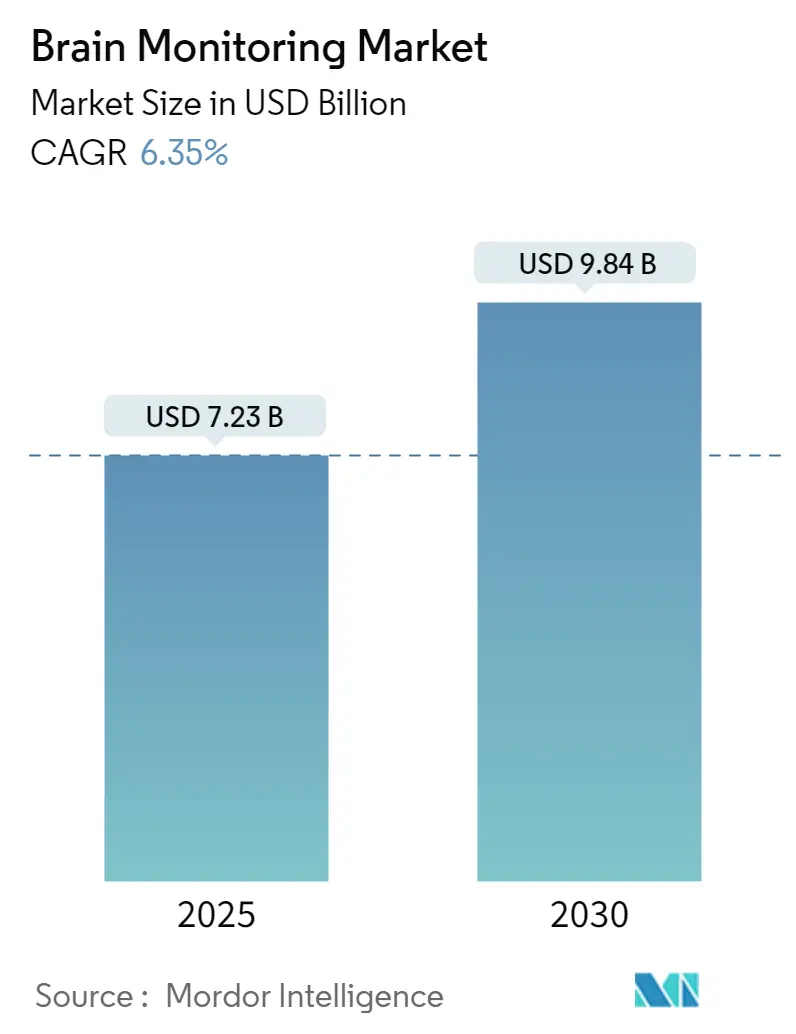
Brain Monitoring Market Analysis
The Brain Monitoring Market size is estimated at USD 7.23 billion in 2025, and is expected to reach USD 9.84 billion by 2030, at a CAGR of 6.35% during the forecast period (2025-2030).
- The COVID-19 pandemic significantly impacted the healthcare system, including the brain-monitoring devices market. Neurological screenings were delayed or canceled due to the global lockdown, leading to reduced access to care for people with epilepsy and negative consequences for people with Parkinson's disease. However, as brain monitoring services resumed and COVID-19 cases decreased, the market is expected to recover from the pandemic's decline.
- Several factors are driving the growth of the market, including aging demographics, the rising incidence of brain disorders, and the ease of device use and portability. For example, the population of Americans aged 65 and older is projected to grow from 58 million in 2021 to 88 million by 2050, with around 73% affected population aged 75 or older. Neurological diseases such as autism are prevalent worldwide, with World Health Organization (WHO) predicting that one in 100 children worldwide has autism. Thus, the increasing prevalence of brain disorders is expected to impact the growth of the brain monitoring market favorably.
- Strategic activities such as product launches, mergers, and acquisitions are also expected to bolster market growth. For example, NeuroWave Systems Inc. received Food and Drug Administration (FDA) clearance for its NeuroSENSE NS-901 Monitor, a brain function monitor for assessing anesthesia and sedation adequacy in clinical settings. Brain Scientific received FDA clearance for Next-Gen NeuroCap EEG Headset, an advanced electroencephalography (EEG) electrode array used to obtain rapid EEGs in routine clinical and research settings.
- Despite these factors, stringent regulations for device approval and a lack of skilled professionals are expected to restrain market growth. Overall, the brain monitoring devices market is expected to witness significant growth over the forecast period, driven by the increasing prevalence of brain disorders and product launches..
Brain Monitoring Market Trends
Electroencephalograph is Expected Witness a Healthy Growth Over the Forecast Period
- The electroencephalography (EEG) machine is a device that captures the electrical activity of the brain through electrodes placed on a person's scalp. These electrodes record brain wave patterns, which are then transferred to a computer or cloud server for analysis. The use of EEG machines is becoming increasingly important in intensive care units (ICUs) as they allow for real-time monitoring of the cerebral activity of critically ill patients. The primary reason for obtaining an EEG in the ICU is to detect seizures in patients with and without acute brain injury.
- Factors such as the increase in brain disorders and the growing adoption of EEG devices across different regions for the detection of brain issues are expected to drive market growth. For example, a survey conducted by the National Institute of Health in July 2022 across hospitals in the United States found that the use of an EEG device significantly improved electrographic seizure diagnosis by physicians. The sensitivity of electrographic seizure diagnosis increased from 77.8 to 100%, and the specificity improved from 63.9 to 89% compared to clinical diagnosis alone. This underscores the importance of EEG in the accurate diagnosis of seizures and its high adoption in intensive care units, fueling segment growth.
- Moreover, advances in EEG devices are contributing significantly to the increasing demand for these devices. For instance, in March 2022, brain.space, an Israel-based company, developed a wireless EEG device that provides superior readings to traditional ones and can be set up without expert help. The cost-effectiveness and ease of use of this device are expected to attract significant attention in the coming years.
- Additionally, in May 2021, Inspira Medical Centers Mullica Hill and Vineland, part of Inspira Health, launched the Ceribell Rapid Response EEG monitoring device. This ground-breaking technology helps identify and diagnose non-convulsive seizure activity in critically ill patients, ensuring that they receive the best care possible as soon as possible.
- Therefore, due to the increasing adoption of EEG devices and the rise in product launches, the EEG machine segment is expected to witness significant growth over the forecast period.
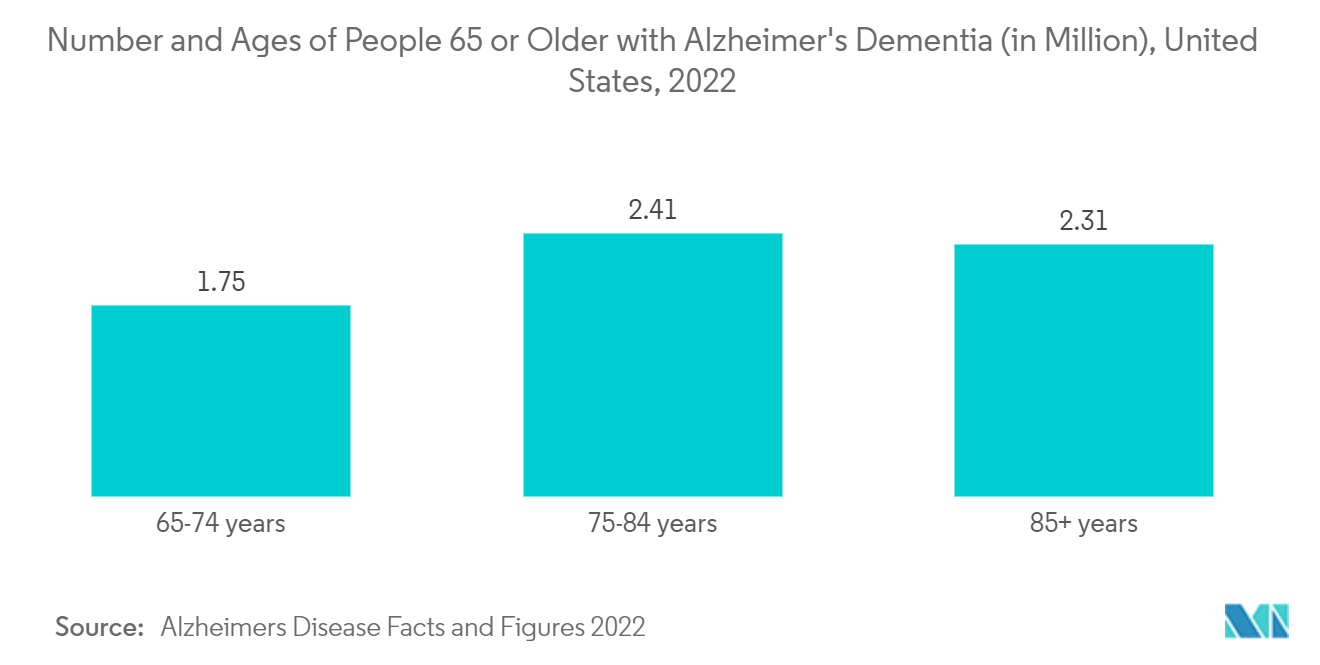
North America Anticipated to Hold a Significant Market Share Over the Forecast Period
- North America is poised to capture a significant share of the brain monitoring device market, driven by several factors. The region benefits from a well-established healthcare infrastructure, an increase in healthcare expenditure, and a rising aging population, which are key drivers of market growth. Additionally, continuous product launches by major players and a high incidence of brain disorders in the region are expected to have a positive impact on market growth.
- For instance, according to a report by the Brain Injury Association of America published in March 2021, around 3.5 million Americans suffer from traumatic brain injuries annually. This report also revealed that out of the total injuries reported, approximately 2.8 million resulted in hospitalizations, and one in every 60 people suffers from traumatic brain injuries-related disability. As brain monitoring devices are essential for continuous monitoring and treatment of traumatic brain injuries, the increase in the incidence of these injuries is expected to boost demand for such devices.
- Moreover, favorable reimbursement policies and increasing technological advancements, including the development of mobile EEG machines, real-time monitoring, and alerts, have also contributed to the market growth in the region. In May 2022, Philips received 510(k) clearance from the FDA for its new MR 7700 3.0T MR system, which allows radiologists to obtain six different clinically relevant nuclei across anatomies.
- Additionally, in January 2022, the Cleveland Clinic launched a brain study aimed at diagnosing and preventing neurological diseases before symptoms occur. This new study collected data from up to 200,000 neurologically healthy individuals over 20 years to identify brain disease biomarkers and targets for preventing and curing neurological disorders.
- In summary, the combination of an increase in brain disorders and the continuous launch of new products is expected to fuel significant growth in the brain monitoring device market in North America over the forecast period.
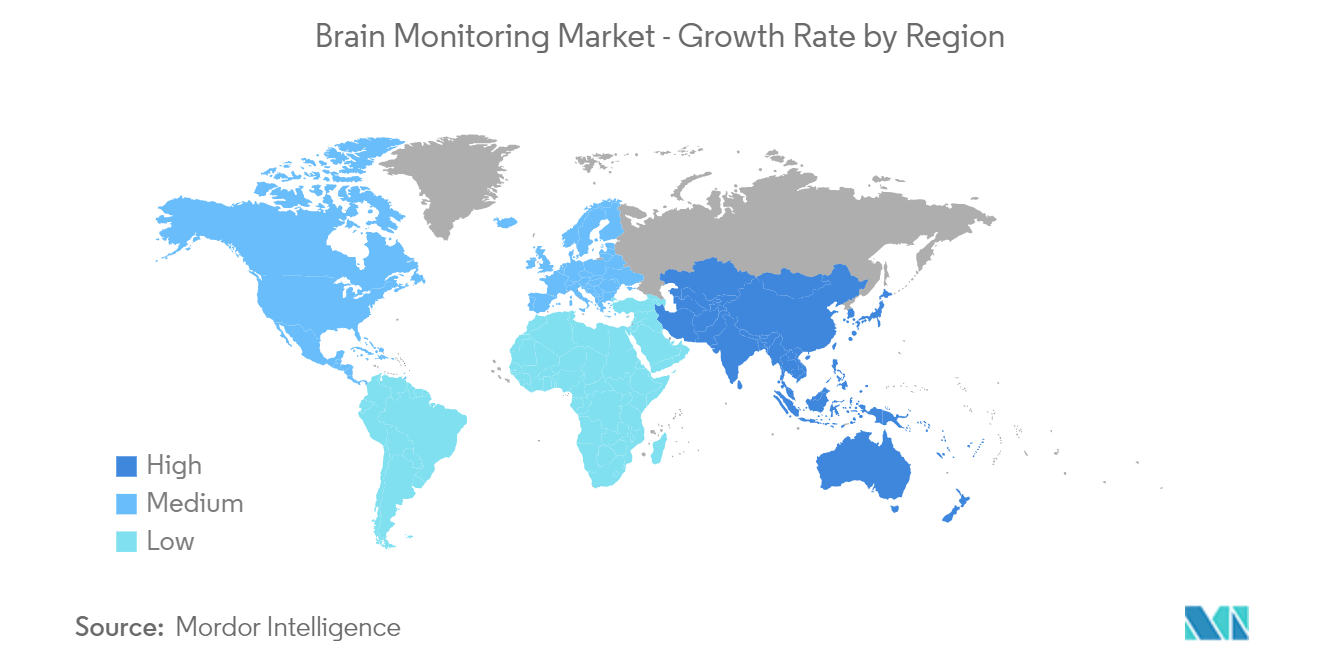
Brain Monitoring Industry Overview
The brain monitoring market is moderately competitive and comprises several significant and small industry players. At present, a few major players dominate the market in specific segments. However, mid-size to smaller companies are increasing their market presence by introducing new technologies with better usability and leveraging technological advancements and product innovations.
Medtronic PLC, Integra LifeSciences Corporation, Nihon Kohden Corporation, Masimo Corporation, and Natus Medical Incorporated are some of the companies that hold a substantial market share in the brain monitoring market.
Brain Monitoring Market Leaders
-
Medtronic PLC
-
Integra LifeSciences Corporation
-
Nihon Kohden Corporation
-
Masimo Corporation
-
Natus Medical Incorporated
- *Disclaimer: Major Players sorted in no particular order
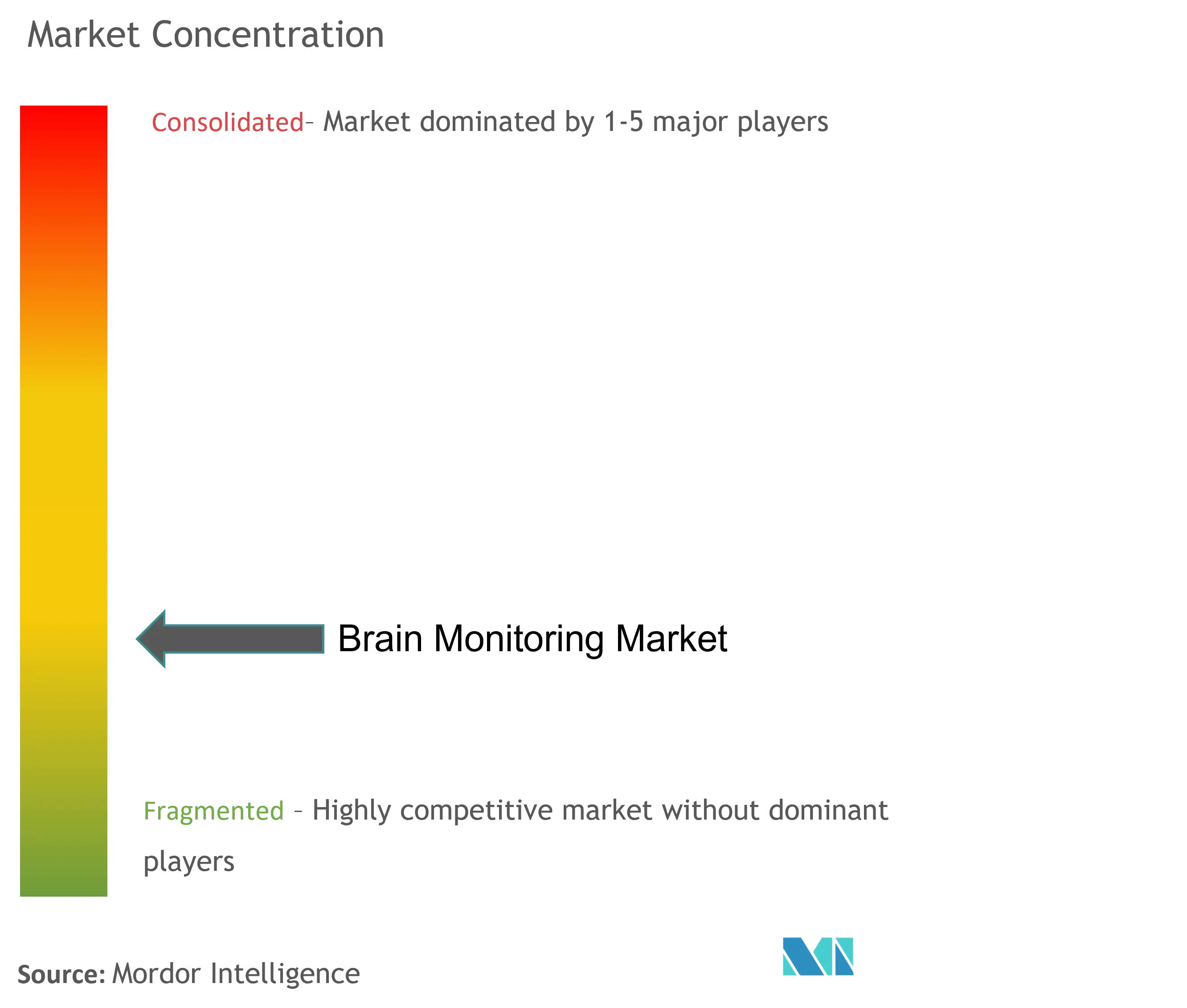
Brain Monitoring Market News
- November 2022: Neurosteer Inc. received FDA clearance for its Neurosteer single-channel EEG brain monitoring platform. This clearance enables the use of Neurosteer's unobtrusive multi-purpose system in a broad range of clinical settings. The platform offers continuous brain monitoring in the ICU to support critical interventions, and aids in the early detection of pre-symptomatic cognitive decline, including Alzheimer's, Parkinson's, and dementia, in a doctor's office. It assists in the rapid and cost-effective massive screening of subjects who may be suffering from neurodegenerative disorders in pharma drug trials.
- February 2022: Masimo received FDA clearance for its SedLine brain function monitoring for pediatric patients (1-17 years of age) and the SedLine Pediatric EEG Sensor. This clearance expands the potential benefits of SedLine to all patients, one-year-old and above, in the United States. SedLine uses Masimo's advanced signal processing technology to help clinicians monitor brain activity bilaterally by processing electroencephalogram (EEG) signals from Masimo's four-lead SedLine EEG sensors.
Brain Monitoring Industry Segmentation
As per the scope of the report, intracranial monitoring is a test for people with epilepsy whose seizures cannot be controlled with medication. Intracranial monitoring helps doctors pinpoint where seizures are starting in the brain. In addition, the tests help 'map' the brain, identifying areas that govern the brain's essential functions.
The brain monitoring market is segmented by product type (magnetoencephalograph, electroencephalograph, cerebral oximeters, functional magnetic resonance imaging (FMRI), intracranial pressure monitoring devices, and other product types), application (Parkinson's disease, traumatic brain injury, epilepsy, dementia, sleep disorders, and other applications), end user (hospitals, and diagnostic centers), and geography (North America, Europe, Asia-Pacific, Middle East, and Africa, and South America). The market report also covers the estimated market sizes and trends for 17 countries across major global regions.'
The report offers the value (USD million) for the above segments.
| By Product Type | Magnetoencephalograph | ||
| Electroencephalograph | |||
| Cerebral Oximeters | |||
| Functional Magnetic Resonance Imaging (fMRI) | |||
| Intracranial Pressure Monitoring Devices | |||
| Other Product Types | |||
| By Application | Parkinson's Disease | ||
| Traumatic Brain Injury | |||
| Epilepsy | |||
| Dementia | |||
| Sleep Disorders | |||
| Other Applications | |||
| By End User | Hospitals | ||
| Diagnostic Centers | |||
| Geography | North America | United States | |
| Canada | |||
| Mexico | |||
| Europe | Germany | ||
| United Kingdom | |||
| France | |||
| Italy | |||
| Spain | |||
| Rest of Europe | |||
| Asia-Pacific | China | ||
| Japan | |||
| India | |||
| Australia | |||
| South Korea | |||
| Rest of Asia-Pacific | |||
| Middle East and Africa | GCC | ||
| South Africa | |||
| Rest of Middle East and Africa | |||
| South America | Brazil | ||
| Argentina | |||
| Rest of South America | |||
Brain Monitoring Market Research FAQs
How big is the Brain Monitoring Market?
The Brain Monitoring Market size is expected to reach USD 7.23 billion in 2025 and grow at a CAGR of 6.35% to reach USD 9.84 billion by 2030.
What is the current Brain Monitoring Market size?
In 2025, the Brain Monitoring Market size is expected to reach USD 7.23 billion.
Who are the key players in Brain Monitoring Market?
Medtronic PLC, Integra LifeSciences Corporation, Nihon Kohden Corporation, Masimo Corporation and Natus Medical Incorporated are the major companies operating in the Brain Monitoring Market.
Which is the fastest growing region in Brain Monitoring Market?
Asia Pacific is estimated to grow at the highest CAGR over the forecast period (2025-2030).
Which region has the biggest share in Brain Monitoring Market?
In 2025, the North America accounts for the largest market share in Brain Monitoring Market.
What years does this Brain Monitoring Market cover, and what was the market size in 2024?
In 2024, the Brain Monitoring Market size was estimated at USD 6.77 billion. The report covers the Brain Monitoring Market historical market size for years: 2019, 2020, 2021, 2022, 2023 and 2024. The report also forecasts the Brain Monitoring Market size for years: 2025, 2026, 2027, 2028, 2029 and 2030.
Our Best Selling Reports
Brain Monitoring Industry Report
Statistics for the 2025 Brain Monitoring market share, size and revenue growth rate, created by Mordor Intelligence™ Industry Reports. Brain Monitoring analysis includes a market forecast outlook for 2025 to 2030 and historical overview. Get a sample of this industry analysis as a free report PDF download.

